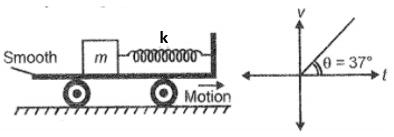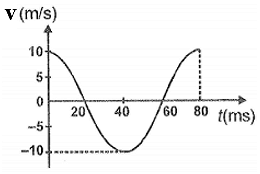A particle executes SHM with a frequency of \(20~\text{Hz}\). The frequency with which its potential energy oscillates is:
1. \(5~\text{Hz}\)
2. \(20~\text{Hz}\)
3. \(10~\text{Hz}\)
4. \(40~\text{Hz}\)
A particle is moving along the x-axis. The speed of particle v varies with position x as . The time period of S.H.M is
1.
2.
3.
4.
A block of mass m is attached to a massless spring having a spring constant k. The other end of the spring is fixed from the wall of a trolley, as shown in the figure. Spring is initially unstretched and the trolley starts moving toward the direction shown. Its velocity-time graph is also shown.

The energy of oscillation, as seen from the trolley is:
1.
2.
3.
4.
A body of mass \(20\) g is executing SHM with amplitude \(5\) cm. When it passes through the equilibrium position its speed is \(20\) cm/s. What would be the distance from equilibrium when its speed becomes \(10\) cm/s?
1. \(\frac{5\sqrt{3}}{4}\) cm
2. \(\frac{5\sqrt{3}}{2}\) cm
3. \(\frac{25\sqrt{7}}{2}\) cm
4. \(5\sqrt{3}\) cm
For a simple harmonic oscillator, a velocity-time diagram is shown. The angular frequency of oscillation is:

1. rad/s
2. rad/s
3. 25 rad/s
4. 25 rad/s
In an S.H.M, when the displacement is one-fourth of the amplitude, the ratio of total energy to the potential energy is
1. 16: 1
2. 1: 16
3. 1: 8
4. 8: 1
A particle executing S.H.M. Its displacement x varies with time t as The maximum velocity of the particle will be:
1. 20 unit
2. 10 unit
3. 40 unit
4. 5 unit
The amplitude of oscillation for a particle executing S.H.M with angular frequency rad/s and maximum acceleration is
1. 25 cm
2. 25 m
3. 5 cm
4. 5 m
Which of the following statements is true for an ideal simple pendulum?
| 1. | The expression for the time period is true only for the oscillation of infinitely small amplitude. |
| 2. | The motion of the bob is rotatory. |
| 3. | The buoyancy of air has an appreciable effect on the motion of the bob. |
| 4. | All of these. |
A mass of 30 gm is attached with two springs having spring constants 100 N/m and 200 N/m and other ends of springs are attached to rigid walls as shown in the given figure. The angular frequency of oscillation is: (Ground is smooth)

1. rad/s
2. rad/s
3. 100 rad/s
4. 200 rad/s


